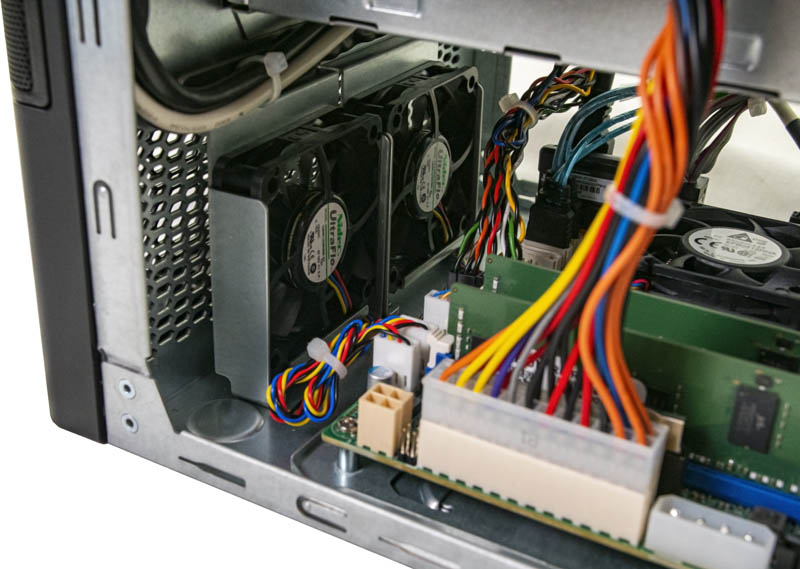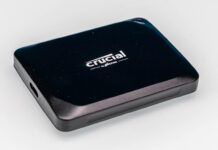FreeNAS Mini XL+ Power Consumption
Power consumption is a big deal in homes and in offices, especially those with high power and air conditioning costs. The FreeNAS Mini XL+ is designed around a low power Atom C3758 SoC, but it also has four fans, a baseboard management controller, and a 10Gbase-T PHY which use a lot of power. We are using 120V power and our Extech TrueRMS Power Analyzer 380803 to measure power consumption. Here is what we saw:
- Idle L2ARC + ZIL SSDs: 33.6W
- Idle L2ARC + ZIL SSDs + 8x WD Red 4TB: 66.8W
- Load: 101.4W
- Maximum observed: 117.3W
Overall, this was great. As you can see, the base system including OS boot media, the L2ARC, and ZIL SSDs was under 34W idle. Beyond that base, the major power consumption drivers are the hard drives. Since there are eight of these devices, we suggest looking at which hard drives you are using.
FreeNAS Mini XL+ Noise
iXsystems claims the Mini XL+ is ultra-quiet. That is important. Desktop NAS units are designed to operate in offices, retail locations, and homes where people are nearby. Fans are great for cooling, but nobody wants to hear them.
Even with adding additional fans, the FreeNAS Mini XL+ did a great job limiting fan noise. We have seen the CPU cooler that is on the system make more noise than the entire Mini XL+ system on standard Supermicro A2SDi boards. It is fairly clear that the iXsystems team did some fan and acoustic tuning. To give some perspective, the FreeNAS Mini XL+ makes the HPE ProLiant ML110 Gen10, HPE’s quiet remote branch office tower server, sound like a jet engine.

The biggest noise in our unit was actually the array of eight hard drives. When they were under heavy load, they generated noise. Helium-filled hard drives tend to issue less noise than our 4TB air-filled WD Red 4TB drives. We highly suggest using Helium-filled drives with the FreeNAS Mini XL+.
Final Words
The FreeNAS Mini XL+ is a well-designed machine. Let us not mince words here. You can build your own FreeNAS 8-bay NAS, and potentially at a lower price. The FreeNAS Mini XL+ is the option to get a system that already has everything selected, assembled, and tuned out of the box. Pretending that does not have value is probably what many commentators will opine but that is simply not the case. Extra effort is invested in development and there are tangible benefits. Cooling is a great example of this. Even the ability to buy the fully configured unit off of Amazon for quick delivery is valuable to someone who needs a unit at a remote branch office tomorrow.
Compared to consumer NAS units, one needs to take one of two views. There is still an ease-of-use gap between FreeNAS and consumer NAS units. FreeNAS still requires more storage knowledge, even if it is not CLI knowledge than consumer offerings. The other view is that the FreeNAS Mini XL+ has management features (e.g. IPMI) and hardware features (e.g. ECC RDIMM support) that are beyond what the consumer NAS offerings support. For an IT admin supporting several remote branch offices, deploying hardware that can be managed like a server is a big benefit. TrueCommand is the next step in managing fleets of FreeNAS devices across sites.
Overall, the unit is well put together. In 2019, an 8-bay NAS needs 10GbE and the updated Intel Atom C3758 provides a lot more compute power in a lower power footprint. Delivering on these means that iXsystems delivered a big upgrade with the FreeNAS Mini XL+.




Maybe I missed it, but I didn’t see the RAIDZ-level configuration.
Well-done review! Extraordinarily thorough. I’ve always thought of these as storage only but you’ve got me thinking about replacing some lightweight VM hosts too.
Misha E. they’ve got RAID-Z on pg3. We use freeNAS and the setup part RAID-Z is very close to RAID-Z2 other than one select box.
Thanks, Stanley.
I wish they’d have a Xeon D option too.
Another great STH review. I’d have liked to have seen compatibility testing with (4) 32gb dimms and (4) 64gb dimms.
Why’d you use 4TB drives not 8 or 10TB drives? I mean if you’re going 8-bay instead of 4-bay wouldn’t you want more capacity than a 4-bay offers? 4x10TB=40TB. 8x4TB=32TB. In your RAIDZ2 you’ve got 20TB usable which is RAID10 like and you’d have 30TB in RAIDZ so more than this 8-bay. You’d also save a load on power and noise with helium 10’s instead of air 4’s.
Supermicro needs that dual fan bracket on their CSE 721
Can anyone tell me what HDD model they use? Thanks
Great review. I just placed an order for a low end TrueNAS X20, maybe I should’ve saved some cash and gotten a pair of FreeNAS Mini XL instead :D
What SuperMicro Board is that running, and if someone has a failed existing freenaz with the asrock board, could they replace it, it’s the same size, but would the backplane be the same ?
@Lukas,
no idea; the configuration/order form on iXSystems online shop does not reveal details about the drives they ship. The review here mentions that the 4 TB drives shipped were some WD Red’s. But then again, since the order page does not disclose any particular drive model that is being shipped, iXSystem might at any time decide to ship different drive models from different manufacturers if they deem those different drives fit for purpose, without you knowing about it until the device is being delivered.
Fortunately, if you don’t want to order a “mystery box”, the FreeNAS Mini’s can also be ordered disk-less (without any drives), leaving it to you to buy drives of your choice from your preferred vendor(s)…
Drive temperatures in that chassi?
What was the RAM configuration? Were there empty slots for upgrading or would you have to replace the sticks that come with the unit?
Will there be an in-depth review of the FreeNAS Mini E as well?
@Lukas, the hard drives are 4 TB WD Reds. Hard drive selection is discussed on page 4 of the review.
@Will I’m looking on P1 and it’s 2x16g sticks and there’s 4 slots so 2 slots open.
ZFS has integrated QuickAssist (QAT) acceleration on some platforms. I am unsure if your version of FreeNAS has that capability. I would be highly interested in seeing the performance of the QAT when QAT-capable versions of ZFS are used. Since it accelerates raidz calculations and compression, this could be very valuable at extending the usable SSD capacity, without sacrificing (much) performance.
We have this in our office. It works flawlessly, my only comment is that those 2 front fans ave quite noisy. I wanted to put this NAS on my desk and I ended up moving it to other room just for the noise.
From a maintenance stand point, I’m curious as to how updates and patching is handled.
While this includes the OS, I’m also wondering about the ipmi and how ixsystems gives us a single point of service.
Background: Supermicro has had it’s share of ipmi security issues and I’ve often found them to lack timely patching and short eol windows. (Ivey Bridge servers are still in production environments, I’d expect ipmi patches to be made available).
Does ixsystems take over from Supermicro?
I have a custom build with the same mainboard Supermicro A2SDi-H-TF and 32GB RAM ECC. Boot drive is a mirrored SSD (Sandisk 120GB). 8x WD Red 8 TB in a RAIDZ2 configuration. I use a Samsung 970 EVO Plus 500GB (onboard NVMe M2 slot) as L2ARC cache and still get only 500-600 MB/s read speed. Then i put a second Samsung 970 EVO Plus 500GB (in PCIe 3.0 x4 slot with Lycom DT-120) as ZIL /SLOG cache and only get 400-550 MB/s write speed. So then i tried to use the second Samsung 970 EVO Plus 500GB as a single drive to get the full speed of the NVMe SSD for video editing over LAN. Even as a single NVME SSD drive the read and write speed are limited to 500-600 MB/s.
I use a Mac Pro 4.1 (flashed to 5.1, PCIe 2.0 x4) with a Sonnet 10G-BaseT PCIe card + Netgear XS505M or the SFP+ approach with MikroTik CRS305 + Sonnet 10G SFP+ PCIe card. Always 500-600 MB/s.
With 8 WD Red (5.400 rpm) in RAIDZ2 configuration i was expecting at least 800-900 MB/s read speed and 700-800 MB/s write speed. Adding NVMe SSD as L2ARC and ZIL / SLOG cache did not boost the performance to saturate the 10 GbE connection.
With iperf3 performance test in both direction i get around 9 Gbit/s. For the read and write speed test of SMB, AFP and NFS shares and iSCSI volume i use BlackMagic Speed Test.
If anyone has any suggestions would be nice to hear.
Zoran,
can you get intel optane 900p drive instead of samsung?
Would be better, than samsung.
I have one installed as zil device, perfect, the 10GBE can be fully saturated by smb.
Patrick,
i would like to get this ablecom cs t80 case to upgrade my 4 bay rig. :-)
I think supermicro and ixsystems gets chassis from the same manufacturer, from ablecom.
The 4 bay case of supermicro is exactly same, than 4 bay freenas case of ixsystems.
I am considering purchasing this computer, however, I am looking forward to running TrueNAS Core running on Debian.
Does anyone know if this computer will support a switch to the new software?